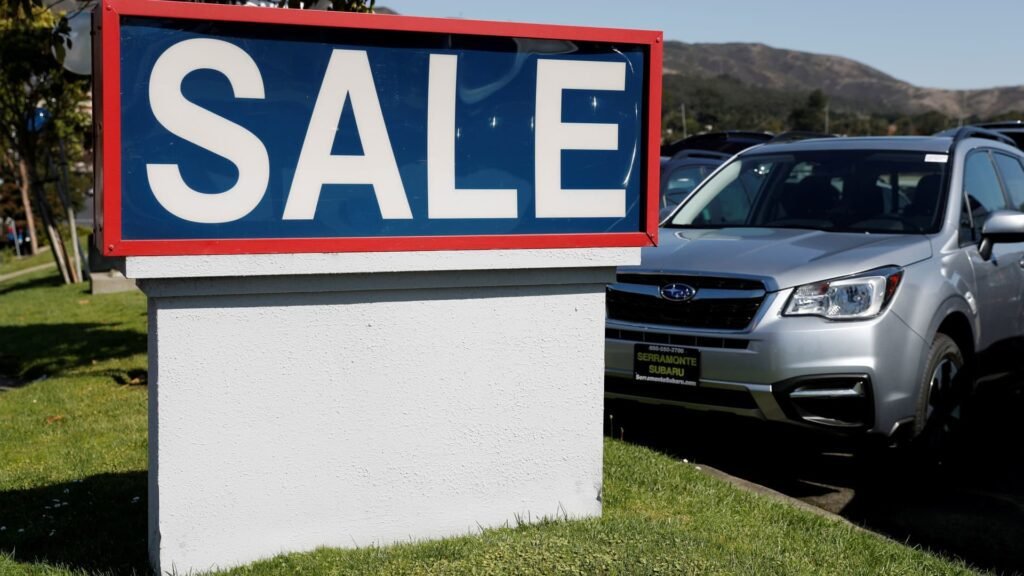A for sale sign can be seen at Serramonte Subaru, a car dealership in Colma, California.
Stephen Lamb | Reuters
DETROIT — Lower interest rates and improved affordability are expected to boost U.S. new car sales next year to the highest level since 2019, according to industry analysts.
Cox Automotive expects new light-duty vehicle sales to reach 16.3 million in 2025, slightly higher than S&P Global Mobility and Edmunds’ sales of about 16.2 million next year. Sales of such vehicles will increase to 16 million from the expected 15.9 million this year, the highest since 2019, when sales were around 17 million.
This equates to less than a 2.5% drop in new car and truck sales forecasts. This increase is expected to be driven by continued “normalization” of vehicle inventories, incentives/discounts from vehicle manufacturers, and relaxation of financing and loan rates.
“While consumers are still feeling the pinch, the market is a slightly friendlier place for car buyers than it was at the beginning of the year,” Jessica Caldwell, head of insights at Edmunds, said in a release Tuesday. said.
One of the biggest growth markets is expected to be entry-level, low-cost cars. The industry has been dealing with high prices and declining inventories for years since the coronavirus pandemic.
Edmunds reports that the average transaction price for a new car in 2024 will be $47,465, a decrease of 0.8% compared to $47,851 in 2023 and 27.2% compared to $37,310 in 2019. Increased.
EV
Another area of growth is expected to be in electric vehicles, including hybrids, plug-in hybrids and all-electric models, analysts said.
All-electric vehicle sales in the U.S. are expected to set a new record in 2024, with total sales approaching 1.3 million, Cox said. This represents a market share of about 8%, up from 7.6% a year ago, but lower than the 10% expected earlier this year.
This is despite expectations that the US EV leader will decline year over year. teslasales for the first time since 2014.
“The top three manufacturers are Tesla, Hyundai Motor Group, general motorsGM had the largest year-over-year market share increase at the brand level, at 2.7%. “While Tesla’s market share has fallen below 50%, the Model Y and Model 3 continue to hold the top two positions,” said Stephanie Valdez Streeti, director of industry insights at Cox, on Tuesday. Tesla. ”
Cox predicts that by 2025, about 25% of new car sales will be electric, including more than 10% all-electric models.
Valdez-Striti and others warned that EV sales could slump if the federal consumer credit program for vehicle purchases of up to $7,500 is eliminated, which the Trump administration has pledged to eliminate.
“Fundamental destruction”?
Analysts warned that regulatory uncertainty ahead of President-elect Donald Trump’s inauguration could impact U.S. new car sales. Most notably, President Trump’s tariff threats could impact auto production in Canada and Mexico.
Jonathan Smoak, chief economist at Cox Automotive, said Trump’s tariffs on these countries, which he has said could be as high as 25%, would cause “fundamental disruption” to the U.S. new car market. .
US President-elect Donald Trump speaks at Mar-a-Lago in Palm Beach, Florida, USA on December 16, 2024.
brian snyder reuter
“While we recognize that there may be twists and turns associated with policy shifts, the key premise we are making is that most policy shifts are likely to take time and that policy implementation will take time. There are some things that are likely to actually drive demand before it gets pushed forward,” Smoak said during a virtual briefing Tuesday. “Specifically as it relates to tariffs, we do not foresee large-scale new tariffs being implemented.”
An expected increase in U.S. new car sales could actually be counterintuitive to some automakers’ profits next year due to higher incentive rates and expected lower prices, Wall Street analysts say. .
“We continue to see signs that pricing is not sustainable,” Wells Fargo analyst Colin Langan said in a note to investors on Monday, with increased inventory, increased incentives and dealer profits per vehicle. , as well as a general decline in automakers’ pricing power.
Prices are still near record highs, but growth is slowing, which is good for car buyers and bad for businesses.




